Yoga Asana Class 7 Notes Physical Education Unit 6 Chapter 3 Free PDF
| Table of contents |

|
| Introduction |

|
| Types of Āsanas |

|
| Breathing Techniques |

|
| Relaxation and Importance of Prāṇāyāma |

|
| Conclusion |

|
Introduction
Āsana is the third limb of Ashtāṅga Yoga and refers to a comfortable, steady posture. These postures (or āsanas) are designed to improve strength, flexibility, and balance.
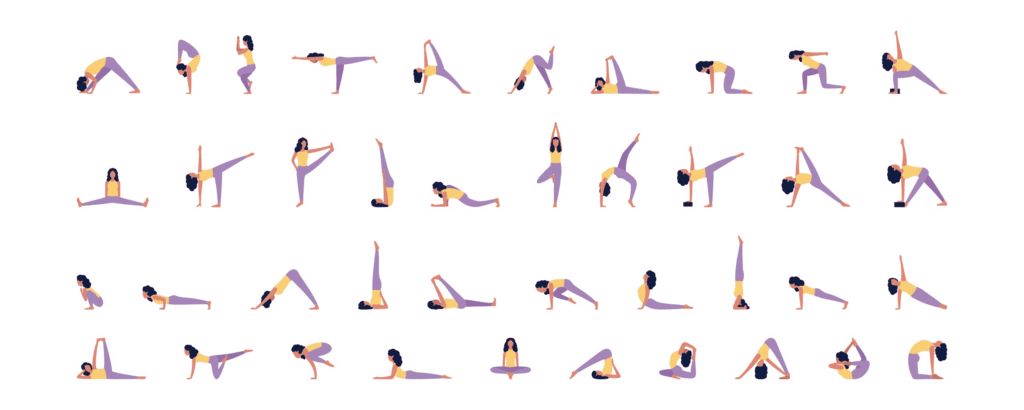 Yoga Asanas
Yoga Asanas
- Yoga postures are not merely exercises; they are an integral part of a holistic lifestyle that supports both physical and mental well-being.
- Hatha Yoga, which focuses on physical postures, identifies 32 special poses that are believed to improve balance, energy flow, and health.
In this chapter, we will learn the following āsanas:
- Standing: Utkaṭāsana (Chair Posture)
- Sitting: Gomukhāsana (Cow’s Face Posture)
- Prone: Sarla Danurāsana (Bow Posture)
- Supine: Sarvāṅgāsana (Shoulder Stand) & Matsyāsana (Fish Posture)
Types of Āsanas
Hatha Yoga, a popular type of Yoga, focuses on physical postures. It highlights 32 special poses that are believed to improve balance, help your body's energy flow smoothly and keep you healthy.
In this grade we shall learn following āsanas:
1. Utkaṭāsana (Chair Posture)
Steps:
- Start in Tādāsana (Mountain Pose).
- Inhale and raise both hands so that the biceps touch the ears. Keep both hands parallel to each other.
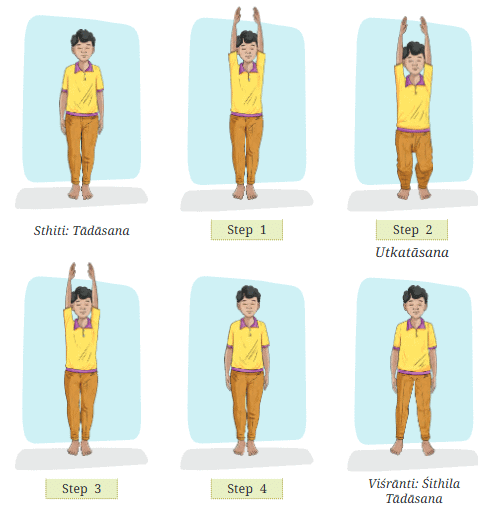
- Exhale and bend the knees, lowering the hips until the body resembles the shape of a chair. Hold this position for 10 counts, breathing normally.
- Inhale to straighten the knees and return to standing.
- Exhale to lower the hands back to your sides.
Benefits:
- Strengthens and stabilizes the ankles, thighs, calf muscles, and spine.
- Stretches the shoulders and chest, easing respiration.
- Improves concentration.
Limitations:
Students with knee pain, sprained ankles, or ligament injuries should avoid this posture.
2. Gomukhāsana (Cow’s Face Posture)
Steps:
- Start in a seated position and fold the right leg, placing the heel by the left buttock.
- Fold the left leg and place the left heel by the right hip, stacking the knees, with the left knee on top.
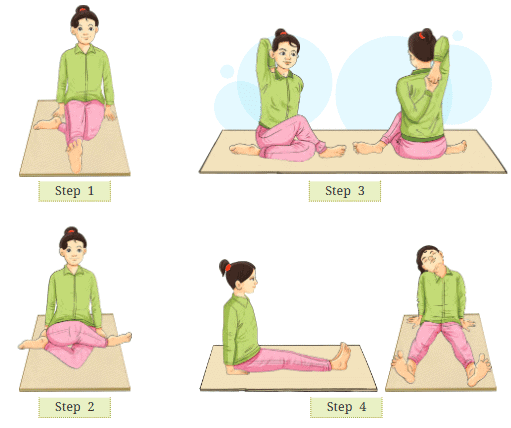
- Inhale and raise both hands sideways. Bring the left arm above the head and bend the elbow. Simultaneously, bring the right arm behind and interlock the fingers.
- Keep the spine erect, head slightly back, and eyes closed.
- Hold the posture for 10 counts, breathing normally.
- Exhale, gently release the hands and legs, and return to the starting position.
Benefits:
- Improves posture and relieves stiffness in the shoulders, neck, and legs.
- Strengthens the ankles, hips, thighs, shoulders, back, and chest.
- Improves respiration and helps reduce anxiety, stress, and tiredness.
Limitations:
- Those with acute knee and ankle problems should avoid this practice initially.
3. Dhanurāsana (Bow Posture)
Steps:
- Start in Prone Posture.
- Inhale and bend both legs at the knees, catching the ankles with both hands.
- Raise the head and chest as high as possible, tilting the head slightly back to form a bow-like shape.
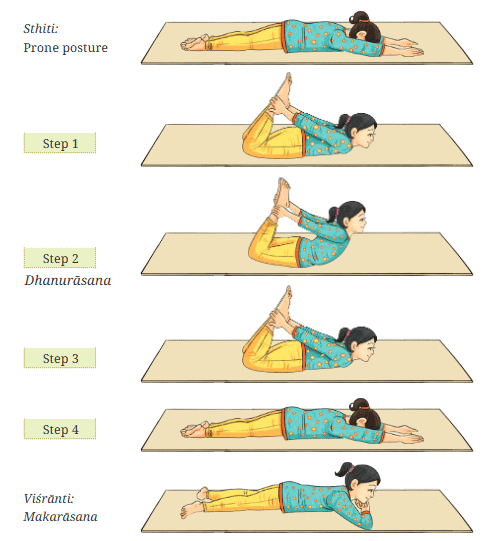
- Hold the position for 10 counts, breathing normally.
- Exhale, slowly lower the head and thighs to the ground.
- Release the hands and legs, and rest the forehead on the ground.
Benefits:
- Improves spinal flexibility and strengthens the back muscles.
- Opens the chest and shoulders, easing respiration.
- Enhances digestion and stimulates the abdominal organs.
Limitations:
Avoid practicing this posture if you have ankle, wrist, or spinal injuries.
4. Sarvāṅgāsana (Shoulder Stand)
Steps:
- Start in Supine Posture.
- Inhale and raise both legs to a 45° angle without folding the knees.
- Inhale further and raise both legs to a 90° angle.
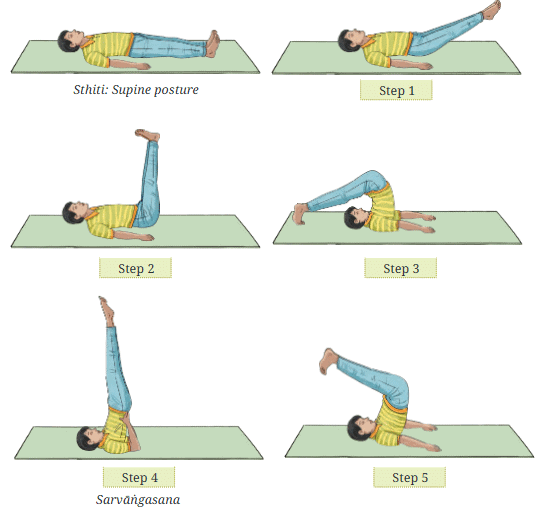
- Exhale and bring both legs backward, parallel to the ground, and place the hands on the floor for support.
- Slowly raise the body upwards while ensuring the chin touches the chest.
- Hold the posture for 10 counts with normal breathing.
- Exhale and lower the legs back to the ground.
Benefits:
- Improves neck flexibility and enhances blood circulation to the brain, eyes, and ears.
- Strengthens legs, arms, and shoulders while keeping the spine flexible.
- Stimulates the thyroid and parathyroid glands and promotes overall mood enhancement.
Limitations:
Avoid if you have respiratory disorders, neck injuries, or eye disorders such as high myopia.
5. Matsyāsana (Fish Posture)
Steps:
- Start in Supine Posture.
- Inhale and exhale to fold the right leg and place it on the left thigh.
- Fold the left leg and place it on the right thigh.
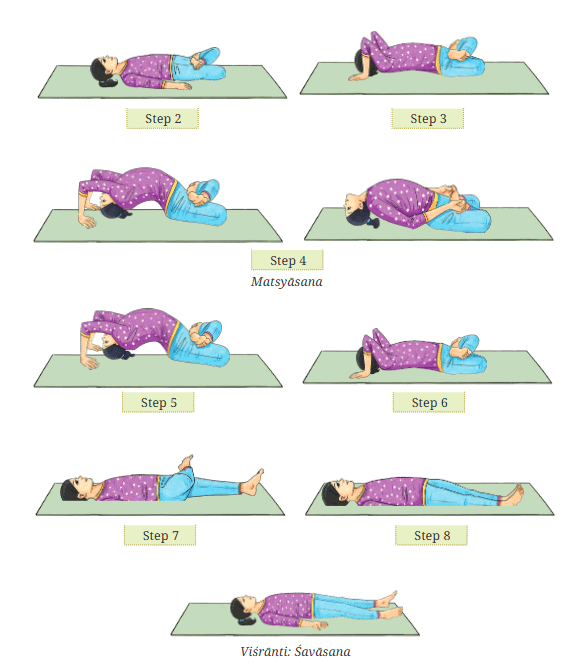
- Place your palms beside your neck and slowly raise the head to rest the crown of the head on the ground.
- Keep the feet together and hold the toes with your hands.
- Maintain the posture for 10 counts with normal breathing.
- Exhale to release the legs and relax in Śavāsana.
Benefits:
- Stimulates the thyroid glands, promoting their normal functions.
- Keeps the spine flexible and healthy.
- Relieves tension in the neck and shoulders.
- Improves lung capacity, beneficial for asthma and bronchitis.
Limitations:
Avoid if you have abdominal or thoracic surgery, neck injury, hernia, or peptic ulcers.
Breathing Techniques
1. Marjariāsana (Cat Stretch Pose)
Steps:
- Start in Dāndāsana (seated position).
- Lean forward and place your hands flat on the floor, in line with your shoulders.
- Inhale and arch the back, looking up.
- Exhale and arch the back upwards, bringing your chin toward your chest.
- Repeat for 5 rounds.
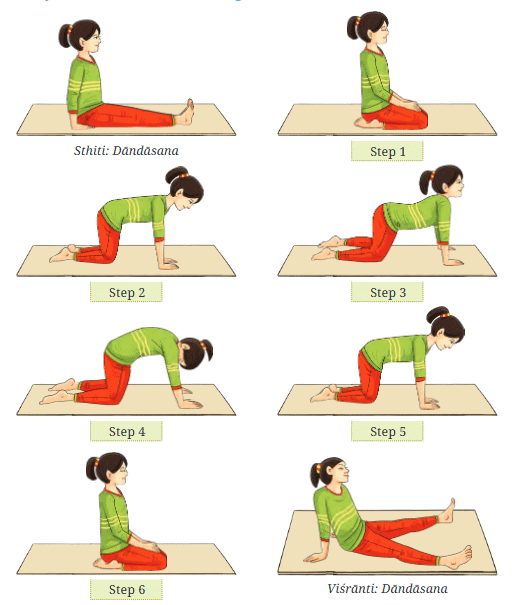 Benefits:
Benefits:
Improves flexibility of the neck, shoulders, and spine.
Limitations:
Avoid if you have knee pain.
2. Vygrahāsana (Tiger Stretch Pose)
Steps:
- Start in Dāndāsana.
- Lean forward, place hands on the floor, and align your body.
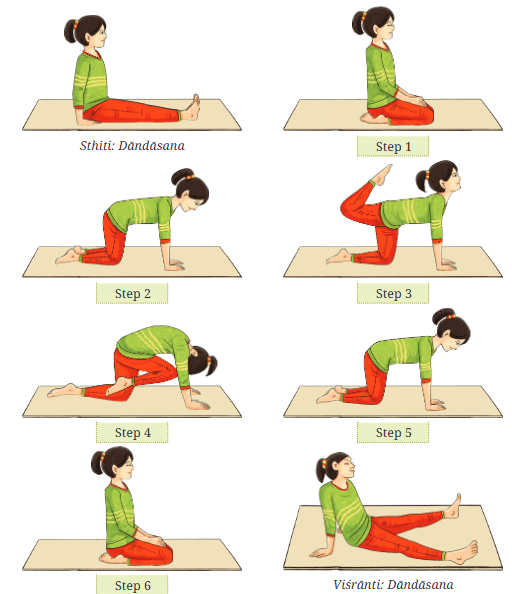
- Inhale, raise the head and the right leg.
- Exhale and bend the knee toward the nose.
- Repeat for 3–5 rounds.
Benefits:
- Loosens the hips and legs.
- Improves digestion and stimulates circulation.
Limitations:
Avoid if you have knee pain or injury.
Relaxation and Importance of Prāṇāyāma
- After performing the āsanas, it's essential to relax the body and calm the mind.
- This can be done by practicing Śavāsana (Corpse Pose), which helps to release muscle tightness and bring peace to the body and mind.

- Prāṇāyāma should be practiced after relaxation to enhance the body’s energy flow and increase mindfulness.
Conclusion
- Yoga Asanas are essential for improving physical strength, flexibility, and balance.
- They also contribute to mental calmness and clarity.
- Regular practice of these āsanas helps in developing a strong body, a focused mind, and a peaceful life.
FAQs on Yoga Asana Class 7 Notes Physical Education Unit 6 Chapter 3 Free PDF
| 1. What are the different types of Āsanas and their benefits? |  |
| 2. How do breathing techniques enhance the practice of yoga? |  |
| 3. Why is relaxation important in yoga practice? |  |
| 4. What is Prāṇāyāma and how does it relate to yoga? |  |
| 5. How can beginners start practicing Āsanas safely? |  |














